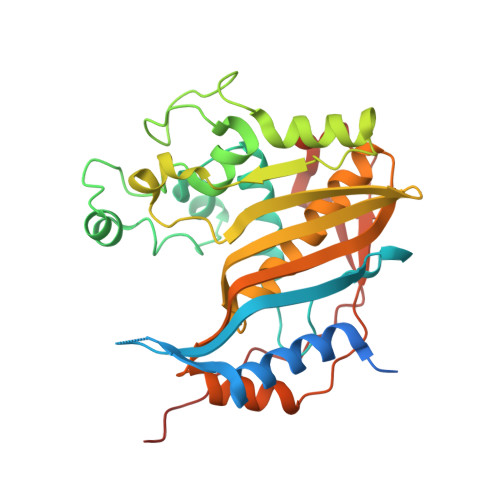Molecular Mechanism of Thymidylate Synthase Inhibition by N 4 -Hydroxy-dCMP in View of Spectrophotometric and Crystallographic Studies.
Maj, P., Jarmula, A., Wilk, P., Prokopowicz, M., Rypniewski, W., Zielinski, Z., Dowiercial, A., Bzowska, A., Rode, W.(2021) Int J Mol Sci 22
- PubMed: 33946210
- DOI: https://doi.org/10.3390/ijms22094758
- Primary Citation of Related Structures:
5M4Z, 6F6Z - PubMed Abstract:
Novel evidence is presented allowing further clarification of the mechanism of the slow-binding thymidylate synthase (TS) inhibition by N 4 -hydroxy-dCMP (N 4 -OH-dCMP). Spectrophotometric monitoring documented time- and temperature-, and N 4 -OH-dCMP-dependent TS-catalyzed dihydrofolate production, accompanying the mouse enzyme incubation with N 4 -OH-dCMP and N 5,10 -methylenetetrahydrofolate, known to inactivate the enzyme by the covalent binding of the inhibitor, suggesting the demonstrated reaction to be uncoupled from the pyrimidine C(5) methylation. The latter was in accord with the hypothesis based on the previously presented structure of mouse TS (cf. PDB ID: 4EZ8), and with conclusions based on the present structure of the parasitic nematode Trichinella spiralis , both co-crystallized with N 4 -OH-dCMP and N 5,10 -methylenetetrahdrofolate. The crystal structure of the mouse TS-N 4 -OH-dCMP complex soaked with N 5,10 -methylenetetrahydrofolate revealed the reaction to run via a unique imidazolidine ring opening, leaving the one-carbon group bound to the N(10) atom, thus too distant from the pyrimidine C(5) atom to enable the electrophilic attack and methylene group transfer.
- Nencki Institute of Experimental Biology, Polish Academy of Sciences, 3 Pasteur St., PL-02-093 Warszawa, Poland.
Organizational Affiliation:


















